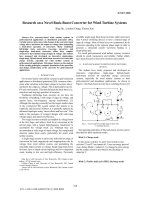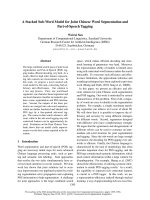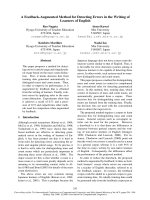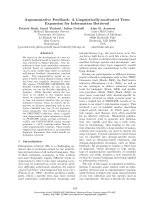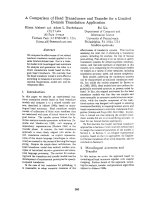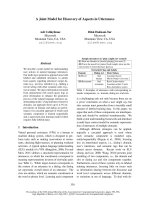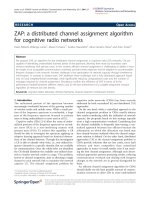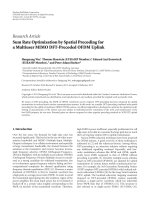A limited feedback joint precoding for AF relay networks TSP10
Bạn đang xem bản rút gọn của tài liệu. Xem và tải ngay bản đầy đủ của tài liệu tại đây (962.38 KB, 11 trang )
IEEE TRANSACTIONS ON SIGNAL PROCESSING, VOL. 58, NO. 3, MARCH 2010
1347
A Limited Feedback Joint Precoding for
Amplify-and-Forward Relaying
Yongming Huang, Luxi Yang, Member, IEEE, Mats Bengtsson, Senior Member, IEEE, and
Björn Ottersten, Fellow, IEEE
Abstract—This paper deals with the practical precoding design
for a dual hop downlink with multiple-input multiple-output
(MIMO) amplify-and-forward relaying. First, assuming that full
channel state information (CSI) of the two hop channels is available, a suboptimal dual hop joint precoding scheme, i.e., precoding
at both the base station and relay station, is investigated. Based
on its structure, a scheme of limited feedback joint precoding
using joint codebooks is then proposed, which uses a distributed
codeword selection to concurrently choose two joint precoders
such that the feedback delay is considerably decreased. Finally,
the joint codebook design for the limited feedback joint precoding
system is analyzed, and results reveal that independent codebook
designs at the base station and relay station using the conventional
Grassmannian subspace packing method is able to guarantee that
the overall performance of the dual hop joint precoding scheme
improves with the size of each of the two codebooks. Simulation
results show that the proposed dual hop joint precoding system
using distributed codeword selection scheme exhibits a rate or
BER performance close to the one using the optimal centralized
codeword selection scheme, while having lower computational
complexity and shorter feedback delay.
Index Terms—Amplify-and-forward relaying, dual hop, Grassmannian codebook, joint precoding, limited feedback, multipleinput multiple-output.
I. INTRODUCTION
T
HE introduction of relaying technology in cellular networks shows large promise to increase coverage and
system capacity at a low cost and is therefore considered in
Manuscript received November 23, 2008; accepted September 09, 2009. First
published November 06, 2009; current version published February 10, 2010. This
work was supported in part by the National Basic Research Program of China
by Grant 2007CB310603, the National Natural Science Foundation of China by
Grants 60902012 and 60672093, the National High Technology Project of China
by Grant 2007AA01Z262, Ph.D. Programs Foundation of the Ministry of Education of China under Grant 20090092120013, the European Research Council
under the European Community’s Seventh Framework Programme (FP7/20072013)/ERC Grant agreement no. 228044, and by the Huawei Technologies Corporation. The associate editor coordinating the review of this manuscript and
approving it for publication was Dr. Shahram Shahbazpanahi.
Y. Huang is with the School of Information Science and Engineering, Southeast University, Nanjing 210096, China. He is also with the ACCESS Linnaeus
Center, KTH Signal Processing Lab, Royal Institute of Technology, SE-100 44
Stockholm, Sweden (e-mail: ).
L. Yang is with the School of Information Science and Engineering, Southeast
University, Nanjing 210096, China (e-mail: ).
M. Bengtsson is with ACCESS Linnaeus Center, KTH Signal Processing Lab,
Royal Institute of Technology, SE-100 44 Stockholm, Sweden (e-mail: mats.
).
B. Ottersten is with ACCESS Linnaeus Center, KTH Signal Processing Lab,
Royal Institute of Technology, SE-100 44 Stockholm, Sweden. He is also with
the securityandtrust.lu, University of Luxembourg (e-mail: bjorn.ottersten@ee.
kth.se).
Color versions of one or more of the figures in this paper are available online
at .
Digital Object Identifier 10.1109/TSP.2009.2036061
IMT-Advanced standardization work such as 3GPP LTE-Advanced and IEEE 802.16m. The same holds for Multiple-Input
Multiple-Output (MIMO) technology [1]–[7] and its application in multiuser environments [8]–[14].
As for the combination of MIMO and relaying technology,
most previous studies focus on the information theoretic limits
for multi-antenna relay channels with different protocols.
Capacity bounds of relaying channels in a single MIMO relay
network have been developed in [15], where a regenerative
MIMO relay is considered. For the multiple MIMO relay network, an asymptotical quantitative capacity result is presented
in [16], where distributive diversity is achieved through cooperation among all the nonregenerative relays available in the
network. This paper focuses on practical signalling design for
a dual hop transmission with MIMO relay. Although the use of
regenerative relays employing decode-and-forward (DF) shows
advantages over nonregenerative relays using amplify-and-forward (AF) in many scenarios, it requires much higher delay
tolerance and may cause security problems, thus here we
concentrate on the AF MIMO relaying strategy. For dual hop
transmission with a single MIMO AF relay station, the optimal
linear transceiver design at the relay-destination link has been
developed [17], [18], assuming that the channel state information (CSI) of both the source-relay and relay-destination links
is available at the relay station. It is revealed that such a dual
hop transmission can be transformed into several simultaneous
data streams transmitted over orthogonal subchannels. In the
case of multiple AF relay stations, a relay selection scheme is
presented in [19] to exploit the additional diversity offered by
the multiple relay stations available in the network, where the
preferred relay station is chosen as a function of CSI to implement a dual hop transmission. Moreover, assuming that the CSI
of all the links is available, a quasi-optimal joint design of linear
transceivers at both the source-relay and the relay-destination
links is developed in [20] and [21], which achieves very good
performance while requiring high computational complexity.
Note that the above dual hop transmit schemes all require full
CSI of both two hop channels and are unfortunately infeasible
in practical frequency division duplex (FDD) systems, though
they provide considerable performance gains. To overcome this
problem, a limited feedback beamforming scheme for MIMO
AF relaying was proposed in [22], which employs Grassmannian codebook to reduce the feedback overhead. It can even
be extended to the case where the second order statistics of
channel vectors are used instead of the limited instantaneous
channel knowledge. However, this scheme is only limited in the
beamforming case and its extension to the precoding case (multiple simultaneous data streams) is nontrivial, which usually results in a rate performance loss especially when all the nodes
1053-587X/$26.00 © 2010 IEEE
1348
IEEE TRANSACTIONS ON SIGNAL PROCESSING, VOL. 58, NO. 3, MARCH 2010
are equipped with multiple antennas, due to the fact that the
multiplexing gain offered by MIMO channels can not be fully
exploited. In this paper we aim to design a practical dual hop
transmit scheme which can fully exploit the multiplexing gains
offered by multiple antennas. More specifically, we propose a
limited feedback joint precoding scheme using the criterion of
optimizing the system rate or the BER performance, where the
reduction of both feedback overhead and feedback delay will be
fully considered. The main contributions are listed as follows:
1) We first present a CSI based suboptimal joint precoding
scheme for a dual hop downlink with AF, where the overall
dual hop MIMO channels can be effectively transformed
into several orthogonal subchannels by using the optimal
pairing between the eigenmodes of the dual MIMO channels. Based on this, we then propose a codebook based limited feedback joint precoding scheme, where a distributed
codeword selection (CS) scheme is further proposed based
on the newly derived bounds for the capacity and the mean
square error (MSE) sum of a dual hop MIMO transmission with a linear minimum mean square error (MMSE)
receiver, such that the feedback burden and feedback delay
are both greatly reduced.
2) Furthermore, we investigate the codebook design for the
proposed limited feedback joint precoding scheme, and
disclose that if the conventional method of Grassmannian
subspace packing is separately employed to construct the
codebooks at the base station and relay station, the overall
performance of the dual hop transmit scheme can be guaranteed to improve with the size of each of the two codebooks.
The rest of this paper is organized as follows. In the next
section we introduce the system model for the dual hop joint
precoding. In Section III we investigate the expression of the
optimal joint precoders based on full CSI, and provide a suboptimal joint precoding scheme which can reduce to a limited
feedback scheme. In Section IV we first present a codebook
based joint precoding system using a centralized codeword selection scheme, and then propose a distributed codeword selection scheme to reduce computational complexity and feedback
delay. In Section V we analyze the design criterion of the joint
codebooks used in the dual hop precoding system. Simulation
results are presented in Section VI and conclusions are drawn
in Section VII.
II. SYSTEM MODEL
We consider a dual hop downlink model which consists of a
base station and a relay station transmitting through two time
anslots. We assume that the base station is equipped with
tennas, the relay station is equipped with antennas and the user
antennas. As depicted in Fig. 1,
terminal is equipped with
during the first slot, the base station employs linear precoding
to transmit simultaneous data streams, i.e., a data vector
, to the relay station. Without loss of generality, we assume
, with
denoting the expectation operator.
The received baseband signal at the relay station is written as
(1)
Fig. 1. The signal model for the dual hop joint precoding system.
where
denotes the precoding matrix at the base
station, without loss of generality, we assume
with
being the trace operator,
denotes the
first hop channel matrix between the base station and the relay
denotes the total transmit power at the base station
station,
denotes a white Gaussian noise vector with zero mean
and
.
and variance
Keeping in mind that a multiuser downlink can be transformed into several single-user downlinks by employing
multiple access techniques such as TDMA and OFDMA, here
we concentrate on the single-user dual hop downlink. Moreover, we focus on relay deployments intended for coverage
expansion, where the direct link between the base station and
the user terminal can be neglected due to path loss or severe
shadowing. To succeed a downlink communication between
the base station and the user terminal, during the second slot
the relay station will forward its received signal using a linear
that has to be designed. With
precoding matrix
at the relay station,
should
the transmit power constraint
satisfy that
(2)
The received baseband signal at the user terminal during this
time slot is written as
(3)
where
denotes the second hop channel matrix bedenotes a
tween the relay station and the user terminal, and
.
white Gaussian noise vector with zero mean and variance
Note that in the above system model we can normalize the variand
, and have the effects of large scale
ances of both
and . The
fading incorporated into the noise variances of
key point of the above dual hop joint precoding system lies in
and
, which commonly rethe design of two precoders
quires channel information feedback in FDD systems.
Also, the number of simultaneous data streams should be
carefully determined. It is well known that a MIMO channel
transmit antennas and
receive antennas can be
with
orthogonal subtransformed into a maximum of
channels via singular value decomposition (SVD). The simuldata streams over ortaneous transmission of
thogonal subchannels can fully utilize the multiplexing gain and
is thereby capacity-approaching, while the scheme of always
transmitting a single data stream in general cannot achieve the
HUANG et al.: A LIMITED FEEDBACK JOINT PRECODING
1349
potential rate offered by MIMO channels, due to the fact that the
multiplexing gain cannot be fully exploited in this case. This result can be easily extended to the dual hop MIMO transmission.
Considering that the overall performance of the dual hop downlink is dominated by the worse one of the two hops, it is reasonable to choose the number of simultaneous data streams in our
if possible, instead of always
system equal to
using a single data stream regardless of antenna configuration,
such that the overall rate performance can be optimized.
,
,
, and
are unitary matrices,
where
and
are diagonal matrices with their elements
and
, respectively. Obvibeing the singular values of
and
(and
ously, the ordering of the singular values in
,
the corresponding ordering of the singular vectors in
, 2) influences the specific decomposition expressions.
Here we first assume an arbitrary ordering and leave its optimization to be solved later. By substituting (6) in (4) the MSE
matrix can be rewritten as
III. JOINT PRECODING WITH FULL CSI
This section concentrates on the design of two joint precoders
assuming that full channel state information of the two hops is
available. In difference to the previous related work which aims
at the optimal performance by using an iterative approach, we
are more interested in the suboptimal scheme which has a simple
structure and can provide some insight on the design of a limited
feedback joint precoding scheme.
We consider an MMSE receiver at the user terminal, as shown
in [17], [18], the MSE matrix for the dual hop joint precoding
can be written as (4), shown at the top of the next page.
(7)
The diagonalization of
can be obtained by
(8)
(9)
where
denotes the submatrix formed by the first columns
,
and
are two diagonal matrices with nonnegative
of
and
,
elements denoted as
,
, and
as
respectively. We partition the matrices
(10)
, and
all belong to
,
,
, and
. By substituting (8)–(10) in (7), the MSE
matrix can be simplified as
,
where
(4)
(11)
and
as
express
and
,
respectively, the achieved sum rate can be easily derived as
Then,
The sum rate achieved by an MMSE receiver is upper bounded
by the instantaneous capacity , which can be expressed as [17],
[23]
if
we
further
(12)
(5)
denotes the th diagonal element of ,
dewhere
notes of the determinant of , the factor 0.5 is due to the two
channel uses which are needed by a dual hop downlink, and will
be omitted henceforth for convenience. Obviously, the equality
is diagonal, which means that the capacity
in (5) holds when
is achieved by an MMSE receiver in this case. Therefore, the
and
should first satisfy the condition that the
design of
and
MSE matrix is diagonalized [19]. Let the SVD of
be
(6)
It is shown that with the above joint precoding, the overall dual
hop channel can be transformed into orthogonal subchannels,
with their channel gains each represented by the product of a
and
, while the diagonal matrices
pair of eigenmodes
and
can be viewed as the power allocation for the joint
precoding. Since
does not influence the sum rate, it should
be set to zero to avoid wasting power. The resulting precoding
matrix at the relay station is
(13)
where
and
denote the submatrices formed by the first
columns of
and
, respectively. Aiming to maximize the
sum rate of the dual hop transmission, we need to optimize the
1350
power allocation matrices
optimization problem:
IEEE TRANSACTIONS ON SIGNAL PROCESSING, VOL. 58, NO. 3, MARCH 2010
and
by solving the following
(14)
where the two constraints are obtained from the power constraints at the base station and the relay station. Specifically, the
first constrain is obtained by substituting (8) in
, while the second constraint is obtained by substituting (8)
and (9) in (2). We would like to note here that this optimization should be done over the optimal ordering of the singular
and
, since different ordering will
values at the SVD of
. Defining new notations
give different values of
,
,
, and
, by replacing the notations
in (14) with the newly defined notations, the above optimization
problem can be simplified as
(15)
It is clear from the above steps that the ordering of singular
and
influences both the sum rate
values at the SVD of
and the specific expression of the optimal joint precoders. Thus,
the joint optimal ordering of singular values at the SVD of
and
needs to be addressed. It is seen from (12) that only
singular values of each hop, i.e.,
eigenmodes of each hop,
affect the sum rate. Therefore, the problem reduces to the optimal selection of active eigenmodes from each hop followed
by the optimal pairing of active eigenmodes between the two
hops. Since the sum rate expressed in (12) monotonically inand the eigenmode
,
creases with both the eigenmode
eigenmodes from each
the scheme of selecting the largest
hop will give a maximum sum rate. Moreover, it is found from
(15) that the eigenmode pairing problem is equivalent to the subchannel pairing problem of the dual hop MIMO-OFDM systems
in [20]. The results in [20] showed that it is optimal to pair the
active eigenmodes of the first hop ordered in
with the active eigenmodes of the second hop or, which means that the
dered in
and
optimal joint precoders should be given by the SVD of
both having its singular values arranged in a nonincreasing
order. For notation simplicity, henceforth the SVD expressions
and
refer to a nonincreasing ordering of singular
of
values.
It should be noted that although (8) and (13) provide a simple
expression for the optimal joint precoders, the closed-form
and
solution for the included power allocation matrices
are difficult to obtain. Hammerström et al. [20] showed that
the optimization problem in (15) cannot be exactly solved but
its quasi-optimal solution can be obtained using an iterative
method, and the optimal power allocation schemes at both the
base station and relay station are similar to the waterfilling
scheme in point-to-point MIMO systems. Since it is well
known that an uniform power allocation (UPA) in general only
suffers from slight performance loss compared to the optimal
waterfilling scheme, while having lower cost and reduced
feedback burden in FDD systems, we will use UPA to form
a suboptimal joint precoding scheme. Next we will show that
such a UPA based dual hop joint precoding scheme can reduce
to a practical limited feedback joint precoding scheme.
IV. LIMITED FEEDBACK PRECODING
By employing UPA, it is seen from (8), (13) that the joint
and
can be
precoders with full channel knowledge of
simplified as
(16)
(17)
where is a common scaling to fulfill the transmit power constraint at the relay station. Since it is reasonable to assume that
is available at the relay station and
available at the
user terminal, the above joint precoding solution requires the
to the base station and
to the relay stafeedback of
tion. In order to reduce the feedback burden, we use two codeand
, such that, similar to the precoding
books to quantize
for point-to-point MIMO systems, only the indices of the preferred codewords are required to be fed back to the base station and relay station, respectively. However, the extension of
point-to-point precoding to a dual hop transmission is nontrivial
and the following problems need to be addressed.
and
depend on
and
,
1) Though the optimal
respectively, the codebook based choice of the precoder at
the base station or the relay station is in general a function
and
. In practical FDD systems, however,
of both
only the user terminal may know the channel of both two
hops without feedback. If both two precoders are selected
by the user, it will suffer from a severe feedback delay
due to the fact that the communication between the base
station and the user terminal has to be forwarded by the
relay station. Therefore, the precoder selection and feedback scheme should be carefully designed to reduce the
feedback delay.
2) The criterion for precoding codebook design has been
widely studied in point-to-point MIMO communication
systems. However, it is an open problem whether these
developed codebook design criteria can be directly employed in the dual hop joint precoding systems.
In order to address the first problem, we first present a centralized codeword selection scheme which provides the optimal
performance but a high feedback delay. Then, we propose a suboptimal distributed codeword selection scheme where feedback
delay and complexity are both greatly reduced.
A. Centralized Codeword Selection
We employ precoding according to (16) and (17) and assume
and
have been designed and dethat two codebooks for
and , respectively. In order to maximize the canoted as
HUANG et al.: A LIMITED FEEDBACK JOINT PRECODING
pacity expressed in (5), the codeword selection for
can be written as
1351
and
and
terminal needs), the distributed codeword selection for
should be merely based on
and
, respectively, such
that the feedback overhead and feedback delay can be considerably reduced. To this end, a new objective function, either from
the capacity or the error rate perspective, should be designed.
In this section we will derive bounds for the capacity and the
MSE-trace, and then use them as the objective functions.
with its SVD expression, the MSE matrix
By replacing
in (4) can be simplified as
(18)
Alternatively, considering that the minimization of the trace of
MSE matrix means to some degree the optimization of the error
rate performance of an MMSE receiver, an MSE-trace selection
scheme aiming to minimize the error rate may be employed and
is expressed as
(20)
Based on this, the capacity of the dual hop transmission can be
lower bounded by
(19)
(21)
Obviously, the codeword selection either from the sum rate
and
,
or the error rate perspective is a function of both
which requires the selection operator to know full CSI of both
two hops, and thereby is called a centralized codeword selection scheme. Due to the fact that each calculation of the objective function includes one or two matrix inversions, this centralized selection scheme requires a high computational complexity. Moreover, since full knowledge of the two hop channels
may only be available at the user terminal without feedback in
and
practical FDD systems, the codeword selection for
should be both conducted by the user. Unfortunately, the feedfrom the user terminal to the base
back of selection result for
station has to be forwarded by the relay station, which results in
a high delay.
where
,
,
,
are the eigenvalues of the Hermitian matrix
and
arranged in a nonincreasing order. For a proof, refer to
Appendix A.
Note that this capacity lower bound increases with both
and
, namely, the lower bound increases if
is increased, for any value of
, or increases if
is increased, for any value of
. Since
and
merely depend on
and
respectively, the
and
following distributed codeword selection scheme for
, will maximize the lower bound of the capacity
,
B. Distributed Codeword Selection
In order to reduce the feedback latency, we propose a distributed codeword selection scheme where the codeword selecand
can be concurrently conducted by the relay
tions for
station and the user terminal, respectively. Since in practical
can be available at the relay station without
systems only
can be easily available at the user terfeedback, while only
should be fed forward by the relay station if the user
minal (
(22)
In order that the proposed distributed codeword selection
scheme can minimize the error rate of the dual hop transmission, we derive two upper bounds for the MSE trace. Both
and
, and can
decrease with two decoupled functions of
1352
IEEE TRANSACTIONS ON SIGNAL PROCESSING, VOL. 58, NO. 3, MARCH 2010
be utilized as the codeword selection criteria. Based on (20),
upper bounds of the MSE trace can be expressed as
(23)
(24)
See Appendix B for proofs. Obviously, minimization of the
upper bound in (23) is equivalent to the maximization of the
lower bound in (21). Thus, the distributed codeword selection
scheme of (22) also works from the perspective of minimizing
the error rate. In addition, since the upper bound in (24) is
and
, an alternative
formed by a sum of two functions of
distributed codeword selection scheme, to optimize the error
rate performance, is given as
(25)
V. CODEBOOK DESIGN CRITERIA
We have derived codeword selection schemes for the dual hop
joint precoding system, and it is important that the codebook
and
are designed specifically for the chosen sepair of
lection schemes. Love et al. [5] have shown that the criterion of
maximizing the minimum Grassmannian subspace distance between any pair of codewords is quasi-optimal for point-to-point
precoding systems. In dual hop precoding systems using the
proposed distributed codeword selection scheme, our following
and
using the
analysis shows that a separate design for
conventional Grassmannian subspace packing method is able to
guarantee that the overall performance increases with the size
of each of the two codebooks.
To define a notion of an optimal codebook, we need a
distortion measure with which to measure the average distortion. It is seen from (21), (23), and (24) that when the term
is maximized,
the lower bound of capacity will be maximized, and the upper
bound of MSE trace will be minimized as well. Thus, we utilize
this term as a performance metric and define the following error
difference:
C. Distributed Beamforming Selection
In general, the proposed distributed codeword selection
schemes for the joint precoding system are able to reduce both the
overall feedback delay and the computational complexity, while
they may suffer from a performance loss compared to the centralized selection scheme, due to the fact that the employed selection
objective functions are not the exact capacity or the MSE trace,
but their bounds. However, our following brief analysis shows
that the proposed distributed selection scheme in the special case
) will
of beamforming (it happens when
suffer from no performance loss as compared with the centralized
one, which is consistent with the result found in [22], though
different analyzing methods are used.
For the beamforming case, the MSE matrix in (20) reduces
into a scalar and can be written as
(26)
and
reduce to
As now both
scalars, their eigenvalues are equal to themselves. Also, it
follows from (2), (16), and (17) that
(29)
which is nonnegative for any choices of
and
,
since the first term is the performance metric obtained by the
and
. Furthermore, we will design
optimal precoders of
our codebook pair to minimize the average distortion
(30)
where
denotes the expectation with respect to
and
.
If we define the minimum distances of the codebook pair
as
,
(31)
(27)
namely, the so-called projection two-norm distance between
two subspaces is employed, the average distortion can be upper
bounded as
Substituting (27) in (26), yields
(28)
where
and
. It can be easily derived
and
that the MSE is minimized when both
are maximized, which means that the proposed distributed codeword selection schemes are optimal from
the perspective of both the capacity and the error rate.
(32)
HUANG et al.: A LIMITED FEEDBACK JOINT PRECODING
1353
where
and
denote the sizes of the codebooks
and ,
respectively. For a proof, refer to Appendix C. Similar to the
and
conclusion in [5], assuming that
, we always have that the average disand . Thus, we can design
tortion is decreased with both
and
separately, with each codebook
the codebook pair
constructed to maximize the minimum projection two-norm distance between any pair of codewords.
VI. SIMULATION RESULTS
Monte Carlo simulations are performed to illustrate the
performance of the proposed dual hop joint precoding system
with distributed and centralized codeword selection schemes.
A block fading flat MIMO channel model is used throughout
and
the simulations. The two hop channel matrices
are both assumed to have entries independently and identi, with the large scale factors of
cally distributed with
channels incorporated into the effective noise variances. The
,
antenna configurations are focused on
and
. The
Grassmannian codebook provided in [24] is employed in our
simulations, and we use the same codebook at the base station
and relay station, with its size shown in figures in terms of
the number of feedback bits. The average SNR at the relay
and
,
station and the user terminal are defined as
respectively. For comparison, some optimal or suboptimal
dual hop precoding systems based on full channel state information are also simulated, where the hereinafter mentioned
joint optimal scheme denotes the precoding system in (8) and
(13), the suboptimal scheme denotes the precoding system in
(16) and (17) with uniform power allocation, and the relay
side optimal scheme denotes the system in [17], [18], where
only the precoding matrix at the relay station is optimized
based on full CSI, and its rate performance is calculated as the
information theoretic instantaneous capacity of an equivalent
, the
open-loop MIMO system. Note that in the case of
joint optimal precoding can not be analytically solved since the
.
objective function in (15) is not concave with respect to
Here we use the alternating optimization method presented in
[20] to find the global or local optimum and repeat it with 50
randomly generated starting vectors, using the maximum one
in comparison.
A. Dual Hop Joint Beamforming
This section focuses on the configurations
and
. Since the receiver is
only equipped with single antenna, a joint beamforming, i.e.,
, should be employed. As disclosed in Section IV-C, in
this case the proposed distributed codeword selection scheme
will not result in any performance loss as compared with the
centralized codeword selection scheme, and it reduces to the
same scheme as the one presented in [22]. Fig. 2 shows that the
proposed dual hop joint beamforming scheme using distributed
CS exhibits slight rate loss as compared with the full CSI
based joint optimal beamforming scheme, especially for the
. Fig. 3 illustrates the cumulative
case of
distribution function of the rate achieved by the dual hop joint
beamforming, the results also show a slight gap between the
proposed limited feedback joint beamforming scheme and the
;;
M;L;N
M;L;N ) =
;;
Fig. 2. The rate of the dual hop joint beamforming system with (
) = (2 2 1), 15 dB SNR at the relay station.
(4 4 1) and (
M;L;N
;;
Fig. 3. The cumulative distribution functions of the rate achieved by the proposed dual hop joint beamforming system, with (
) = (4 4 1) and
(
) = (2 2 1), 15 dB SNR at both the receiver and relay station.
M;L;N
;;
joint optimal scheme. Fig. 4 illustrates the BER performance
of the proposed dual hop joint beamforming using QPSK
modulation. Similar results are also observed.
B. Dual Hop Joint Precoding
This section focuses on the configurations
and
. Fig. 5 shows the sum rate of the dual hop
joint precoding system using two different codeword selection
schemes. It is seen that the performances of the dual hop joint
precoding schemes using distributed and centralized CS both
increase with the codebook size. Compared with the centralized
CS, the distributed CS suffers from a slight rate loss. This
is because the distributed CS is based on a bound but not an
exact rate metric. However, the distributed CS has a shorter
feedback delay and requires much lower computational complexity. Also, it is reasonable to see that even the scheme using
centralized CS has a gap from the full CSI based suboptimal
scheme, due to the quantization of the optimal joint precoders.
1354
M;L;N
IEEE TRANSACTIONS ON SIGNAL PROCESSING, VOL. 58, NO. 3, MARCH 2010
;;
M;L;N
;;
Fig. 4. The BER of the proposed dual hop joint beamforming system with
(
) = (4 4 1) and (
) = (2 2 1), 15 dB SNR at the relay
station.
;;
M;L;N
;;
Fig. 6. The cumulative distribution functions of the rate achieved by the proposed dual hop joint precoding system, with (
) = (4 4 2), 15 dB
SNR at both the receiver and relay station.
7. The BER of the proposed dual hop joint precoding system with
M;L;N ) = Fig.
(M;L;N ) = (4; 4; 2) and 15 dB SNR at the relay station.
Fig. 5. The rate of the dual hop joint precoding system with (
(4 4 2) and 15 dB SNR at the relay station.
Moreover, the results reveal that the proposed joint precoding
scheme with distributed CS shows obvious advantage over the
beamforming scheme presented in [22] in terms of the rate
performance, especially in medium-to-high SNR regions. This
is due to the fact that our proposed precoding scheme employs
multiple simultaneous data streams and thus can fully exploit
the multiplexing gain offered by the dual hop MIMO channels.
Fig. 6 shows the cumulative distribution function of the rate
achieved by the dual hop joint precoding system. Similar results
are seen as in Fig. 5.
Interestingly, it is also found from Fig. 5 and Fig. 6 that the
full CSI based suboptimal scheme with UPA shows slight performance loss as compared with the joint optimal scheme, only
in the range of medium-to-high SNRs. And, the relay side optimal scheme shows the worst performance among three full CSI
based schemes, especially in high SNR region. This is due to
the fact that the precoder at the base station is not optimized. It
should also be noted that, though it seems from the curves that
the relay side optimal scheme outperforms the proposed scheme
in most of the SNR region, this is a result of unfair comparison, where the performance of the relay side optimal scheme
is calculated as the instantaneous capacity, but not the sum rate
achieved by an MMSE receiver.
Fig. 7 shows the BER performance of the dual hop joint precoding scheme using QPSK and MMSE receiver. Both the proposed two distributed CS schemes, i.e., (22) and (25), are simulated. It is seen that the BER performance of these two schemes
(denoted as distributed CS #1 and #2) are very close, and they
both increase with the codebook size. Compared with the centralized CS scheme, a loss of less than 2 dB is observed in the
proposed two distributed CS schemes.
VII. CONCLUSION
In this paper we have presented a limited feedback joint
precoding for the dual hop downlink with amplify-and-forward
relaying. The proposed scheme employs a distributed codeword
selection and thus has lower computational complexity and
feedback delay. Also, we have analyzed the joint codebook
HUANG et al.: A LIMITED FEEDBACK JOINT PRECODING
1355
design for the joint precoding system, and revealed that a
separate codebook design for the base station and the relay
station using Grassmannian subspace packing method can
guarantee that the overall performance of the proposed scheme
improves with the size of each of the two codebooks. Finally,
computer simulations have confirmed the advantage of the
proposed scheme in terms of the tradeoff between performance
and complexity, as compared with the limited feedback joint
precoding with a centralized codeword selection.
APPENDIX A
PROOF OF (21)
Assuming that the relay station transmit signal with full power,
it is derived from (2) that
(36)
Thus, we further have
We first present the following matrix inequalities [25]: Given
positive semidefinite Hermitian matrices and
two
with eigenvalues
and
arranged in nonincreasing order, respectively, we have
(37)
(33)
Since the matrix determinant equals the product of the eigenvalues, the capacity of the dual hop transmission with precoders
and
can be rewritten as
This concludes the proof.
APPENDIX B
PROOF OF (23) AND (24)
We first prove the first upper bound of the MSE trace in (23)
(38)
where
(34)
By applying the inequality in (33), this yields
and the inequality in (a) comes from the lower bound of
,
which has been derived in Appendix A.
Similar to the above derivation, the second upper bound of
the MSE trace in (24) can be obtained as follows:
(39)
(35)
This concludes the proof.
1356
IEEE TRANSACTIONS ON SIGNAL PROCESSING, VOL. 58, NO. 3, MARCH 2010
(41)
APPENDIX C
PROOF OF (32)
ACKNOWLEDGMENT
Before the proof of (32), we first give the following inequality. Given arbitrary nonnegative variables , ,
and
, we have [22, Lemma 1]
The authors would like to thank all the anonymous reviewers
and the editor for their valuable comments that have helped to
improve the quality of this paper.
REFERENCES
(40)
With that, the average distortion can now be upper bounded as
shown in (41) at the top of the page, where the inequality is a
result of direct use of (40). Based on the results in [5, eq. 29,
30], the two terms in the right-hand side (RHS) can be further
upper bounded as
(42)
(43)
Thus, the upper bound of the average distortion can modified as
(44)
This concludes the proof.
[1] G. J. Foschini and M. J. Gans, “On limits of wireless communications
in a fading environment when using multiple antennas,” Wireless Pers.
Commun., vol. 6, no. 3, pp. 311–335, 1998.
[2] G. J. Foschini, “Layered space-time architecture for wireless communication in fading environment when using multielement antennas,” Bell
Labs Tech. J., vol. 1, no. 2, pp. 41–59, Aug. 1996.
[3] A. Scaglione, P. Stoica, S. Barbarossa, G. B. Giannakis, and H. Sampath, “Optimal designs for space-time linear precoders and decoders,”
IEEE Trans. Signal Process., vol. 50, no. 5, pp. 1051–1064, May 2002.
[4] H. Sampath, P. Stoica, and A. Paulraj, “Generalized linear precoder
and decoder design for MIMO channels using the weighted MMSE
criterion,” IEEE Trans. Commun., vol. 49, no. 12, pp. 2198–2206, Dec.
2001.
[5] D. J. Love and R. W. Heath, Jr., “Limited feedback unitary precoding
for spatial multiplexing systems,” IEEE Trans. Inf. Theory, vol. 51, no.
8, pp. 2967–2976, Aug. 2005.
[6] Y. Huang, D. Xu, L. Yang, and W. P. Zhu, “A limited feedback precoding system with hierarchical codebook and linear receiver,” IEEE
Trans. Wireless Commun., vol. 7, no. 12, pp. 4843–4848, Dec. 2008.
[7] S. M. Alamouti, “A simple transmit diversity technique for wireless
communications,” IEEE J. Sel. Areas Commun., vol. 16, no. 8, pp.
1451–1458, Oct. 1998.
[8] H. Weingarten, Y. Stenberg, and S. Shamai, “The capacity region of
the Gaussian multiple-input multiple-output broadcast channel,” IEEE
Trans. Inf. Theory, vol. 52, no. 9, pp. 3936–3964, Sep. 2006.
[9] Q. H. Spencer, A. L. Swindelhurst, and M. Haardt, “Zero forcing
methods for downlink spatial multiplexing in multiuser MIMO channels,” IEEE Trans. Signal Process., vol. 52, pp. 461–471, Feb. 2004.
[10] K. K. Wong, R. Murch, and K. B. Letaief, “A joint-channel diagonalization for multiuser MIMO antenna systems,” IEEE Trans. Wireless
Commun., vol. 2, pp. 773–786, July 2003.
[11] N. Jindal, “MIMO broadcast channels with finite-rate feedback,” IEEE
Trans. Inf. Theory, vol. 52, pp. 5045–5060, Nov. 2006.
[12] M. Sharif and B. Hassibi, “On the capacity of MIMO broadcast channels with partial side information,” IEEE Trans. Inf. Theory, vol. 51,
pp. 506–522, Feb. 2005.
[13] D. Xu, Y. Huang, L. Yang, and B. Li, “Linear transceiver design for
multiuser MIMO downlink,” in Proc. IEEE Int. Conf. Commun., May
2008, pp. 761–765.
[14] Y. Huang, L. Yang, and J. Liu, “A limited feedback SDMA for downlink of multiuser MIMO communication system,” EURASIP J. Adv.
Signal Process., vol. 2008, Oct. 2008.
[15] B. Wang, J. Zhang, and A. Høst-Madsen, “On the capacity of MIMO
relay channels,” IEEE Trans. Inf. Theory, vol. 51, no. 1, pp. 29–43, Jan.
2005.
HUANG et al.: A LIMITED FEEDBACK JOINT PRECODING
[16] H. Bolcskei, R. U. Nabar, O. Oyman, and A. J. Paulraj, “Capacity
scaling laws in MIMO relay networks,” IEEE Trans. Wireless
Commun., vol. 5, no. 6, Jun. 2006.
[17] O. Munoz-Medina, J. Vidal, and A. Agustin, “Linear transceiver design
in nonregenerative relays with channel state information,” IEEE Trans.
Signal Process., vol. 55, no. 6, pp. 2593–2604, Jun. 2007.
[18] X. Tang and Y. Hua, “Optimal design of non-regenerative MIMO
wireless relays,” IEEE Trans. Wireless Commun., vol. 6, no. 4, pp.
1398–1407, Apr. 2007.
[19] Y. Fan and J. Thompson, “MIMO configurations for relay channels:
Theory and Practice,” IEEE Trans. Wireless Commun., vol. 5, no. 5,
pp. 1774–1786, May 2007.
[20] I. Hammerström and A. Wittneben, “Power allocation schemes for amplify-and-forward MIMO-OFDM relay links,” IEEE Trans. Wireless
Commun., vol. 6, no. 8, pp. 2798–2802, Aug. 2007.
[21] Z. Fang, Y. Hua, and J. C. Koshy, “Joint source and relay optimization
for a non-regenerative MIMO relay,” in Proc. IEEE Workshop Sens.
Array Multichannel Signal Process., Jul. 2006, pp. 239–243.
[22] B. Khoshnevis, W. Yu, and R. Adve, “Grassmannian beamforming for
MIMO amplify-and-forward relaying,” IEEE J. Sel. Areas. Commun.,
vol. 26, no. 8, pp. 1397–1407, Oct. 2008.
[23] R. W. Heath, Jr., S. Sandhu, and A. Paulraj, “Antenna selection for spatial multiplexing systems with linear receivers,” IEEE Commun. Lett.,
vol. 5, no. 4, pp. 142–144, Apr. 2001.
[24] D. J. Love, Personal Webpage on Grassmannian Subspace Packing
[Online]. Available: />for
0,”
0,
[25] H. Sha, “Estimation of the eigenvalues of
Linear Algebra Its Appl., vol. 73, pp. 147–150, 1986.
AB A > B >
Yongming Huang received the B.S. and M.S. degrees from Nanjing University, China, in 2000 and
2003, and the Ph.D. degree from the School of Information Science and Engineering, Southeast University, China, 2007, respectively.
Since 2007, he has been an Assistant Professor
with the School of Information Science and Engineering, Southeast University. In December 2008,
he joined in the Signal Processing Lab, Electrical
Engineering, Royal Institute of Technology (KTH),
Stockholm, Sweden, as a Postdoctoral Researcher.
His current research interest includes MIMO communication systems, multiuser MIMO communications, and cooperative communications.
Luxi Yang (M’96) received the M.S. and Ph.D.
degree in electrical engineering, from the Southeast
University, Nanjing, China, in 1990 and 1993,
respectively.
Since 1993, he has been with the Department of
Radio Engineering, Southeast University, where he
is currently a professor of Information Systems and
Communications, and the Director of Digital Signal
Processing Division. His current research interests
include signal processing for wireless communications, MIMO communications, cooperative relaying
1357
systems, and statistical signal processing. He is the author or coauthor of two
published books and more than 100 journal papers, and holds 10 patents.
Prof. Yang received the first- and second-class prizes of Science and Technology Progress Awards of the State Education Ministry of China in 1998 and
2002. He is currently a member of Signal Processing Committee of Chinese Institute of Electronics.
Mats Bengtsson (M’00–SM’06) received the M.S.
degree in computer science from Linköping University, Linköping, Sweden, in 1991 and the Tech. Lic.
and Ph.D. degrees in electrical engineering from the
Royal Institute of Technology (KTH), Stockholm,
Sweden, in 1997 and 2000, respectively.
From 1991 to 1995, he was with Ericsson Telecom
AB Karlstad. He currently holds a position as Associate Professor with the Signal Processing Laboratory, School of Electrical Engineering, KTH. His research interests include statistical signal processing
and its applications to antenna-array processing and communications, radio resource management, and propagation channel modeling.
Dr. Bengtsson served as Associate Editor for the IEEE TRANSACTIONS ON
SIGNAL PROCESSING during 2007–2009 and is a member of the IEEE SPCOM
Technical Committee.
Björn Ottersten (S’87-M’89-SM’99-F’04) was
born in Stockholm, Sweden, in 1961. He received
the M.S. degree in electrical engineering and applied
physics from Linköping University, Linköping,
Sweden, in 1986. In 1989, he received the Ph.D.
degree in electrical engineering from Stanford
University, Stanford, CA.
He has held research positions with the Department of Electrical Engineering, Linköping
University, the Information Systems Laboratory,
Stanford University, the Katholieke Universiteit
Leuven, Leuven, and the University of Luxembourg. During 1996–1997, he
was Director of Research at ArrayComm, Inc., a start-up company in San
Jose, CA, based on Ottersten’s patented technology. In 1991, he was appointed
Professor of Signal Processing at the Royal Institute of Technology (KTH),
Stockholm. From 1992 to 2004, he was head of the Department for Signals,
Sensors, and Systems at KTH and from 2004 to 2008 he was dean of the
School of Electrical Engineering at KTH. Currently, he is Director for the
Interdisciplinary Centre for Security, Reliability and Trust at the University of
Luxembourg. His research interests include security and trust, reliable wireless
communications, and statistical signal processing.
Dr. Ottersten has served as Associate Editor for the IEEE TRANSACTIONS ON
SIGNAL PROCESSING and on the editorial board of the IEEE Signal Processing
Magazine. He is currently Editor-in-Chief of the EURASIP Signal Processing
Journal and a member of the editorial board of the EURASIP Journal of Applied
Signal Processing. He has coauthored papers that received the IEEE Signal Processing Society Best Paper Award in 1993, 2001, and 2006. He is a Fellow of the
EURASIP. He is a first recipient of the European Research Council advanced
research grant.
